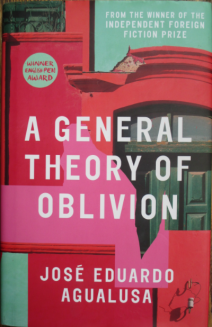
This harrowing and beautiful novel is based on an extraordinary true story. Ludovica Fernandes Mano walled herself up in her apartment in Luanda, Angola for 28 years – in fact, for the entire duration of the Angolan civil war (1975-2002). In telling her story, Agualusa gives us some fleeting glimpses of what life was like in those troubled times – but more importantly, tackles the difficult question of how those days should now be remembered, or forgotten.
At the heart of A General Theory of Oblivion is the story of a woman who was so terrified of the world she decided literally to wall herself away from it. The Portuguese woman Ludovica (Ludo), an agoraphobic since her childhood, confronted by a personal tragedy and then by violence around Angola’s independence, built a wall outside the front door of her apartment and never ventured outside for 28 years. Her strategies for survival could have made a Robinson Crusoe-style book in themselves – growing corn and beans in the flowerbeds, cooking on fires made from old furniture, and using diamonds to catch pigeons on the roof. But Agualusa is more interested in Ludo’s thoughts and literary musings, which she set down in a series of diaries and then, when they ran out, in charcoal on the walls of her apartment. These writings are the standout sections of the book, with an astonishing spare beauty. Although Agualusa insists that his story is ‘pure fiction’, he also says that he made use of Ludo’s actual first hand accounts, so some of these sections may have been written by the real-life woman:
“I couldn’t sleep. At four in the morning I went up onto the terrace. The night, like a well, was swallowing stars. Then I saw a flatbed truck go by, laden with dead bodies.”
“The days slide by as if they were liquid. I have no more notebooks to write in […] I save on food, on water, on fire and on adjectives.”
Ludo’s economical style is matched by the book itself – there is a sense that not a word is wasted, and every character plays a critical part in the story. Besides Ludo we meet an intriguing range of other fictional characters – a couple of street children, an investigative journalist, a political prisoner turned businessman, and agents from both the Angolan government and the Portuguese army who routinely engage in torture but nonetheless come across as human. There are accidental killings, bizarre coincidences and a host of disappearances. By the end of the book even the most unlikely events and chance encounters do not seem strange in a city where real life would seem too improbable even for a dream.
The book’s title comes from one of Ludo’s diary entries: “If I had the space, the charcoal, and available walls, I could compose a great work about forgetting: a general theory of oblivion.” It’s an odd statement in a way, as Ludo’s diaries and wall-scribblings seem to be about recording her experiences and feelings, rather than forgetting them. But it raises a question that the book returns to over and over: in a post-conflict setting, how much should we remember, how much forget, about the dark days before? Ludo tries to forget everything, past and present, to move away from the world entirely. But her mission to forget is doomed: she wants to forget because she is troubled by traumatic memories of the past, and throughout her period of isolation, she is connected to people outside in a series of bizarre ways.

Other characters also muse on the theme of memory and forgetting. The Government security agent is “assailed” by “incredibly clear” memories of his torturing days, and is also worried that others will not forget what he did: “There are some people who experience a fear of being forgotten […] The opposite happened to him, he lived in a terror that he would never be forgotten.” When Ludo confronts the ex-Portuguese army agent, who had done her wrong many years before, she forgives him, urging “Don’t torture yourself any more. Our mistakes correct us. Perhaps we need to forget. We should practice forgetting, reaching for oblivion.” But he is unconvinced: “Forgetting is dying”, “forgetting is surrender.”
Agualusa doesn’t have a glib answer to the question of how much of Angola’s violent and disturbing past to remember and how much to forget. But one thing seems clear: total isolation, total oblivion, is simply not possible. The past, and different memories of the past, shape and define people and countries in ways that they cannot themselves control. In development agencies, we don’t tend to spend much time understanding the past of the countries where we work, rather emphasising the dire need for help now, and the bright new future that we are creating. We may regard the past as part of the problem we are trying to address, for example inertia or ‘traditional practices’ which need to be changed through new policies or programmes. Or we may lose patience with fears and mutual mistrust brought about through years of conflict and violence. But we ignore these memories at our peril. Like the characters in Agualusa’s extraordinary book, we need to find a way of respecting and understanding the past without becoming intimidated by it.